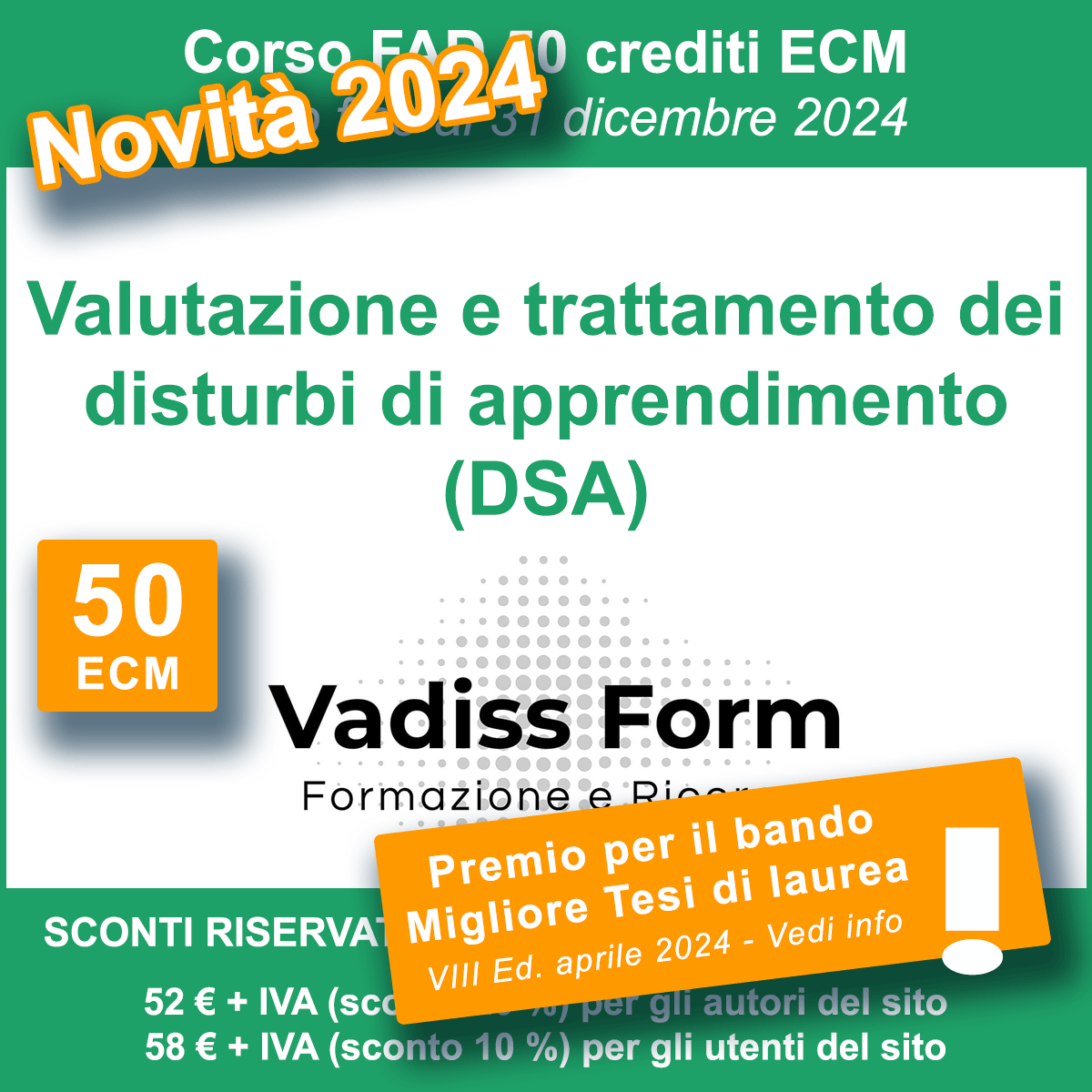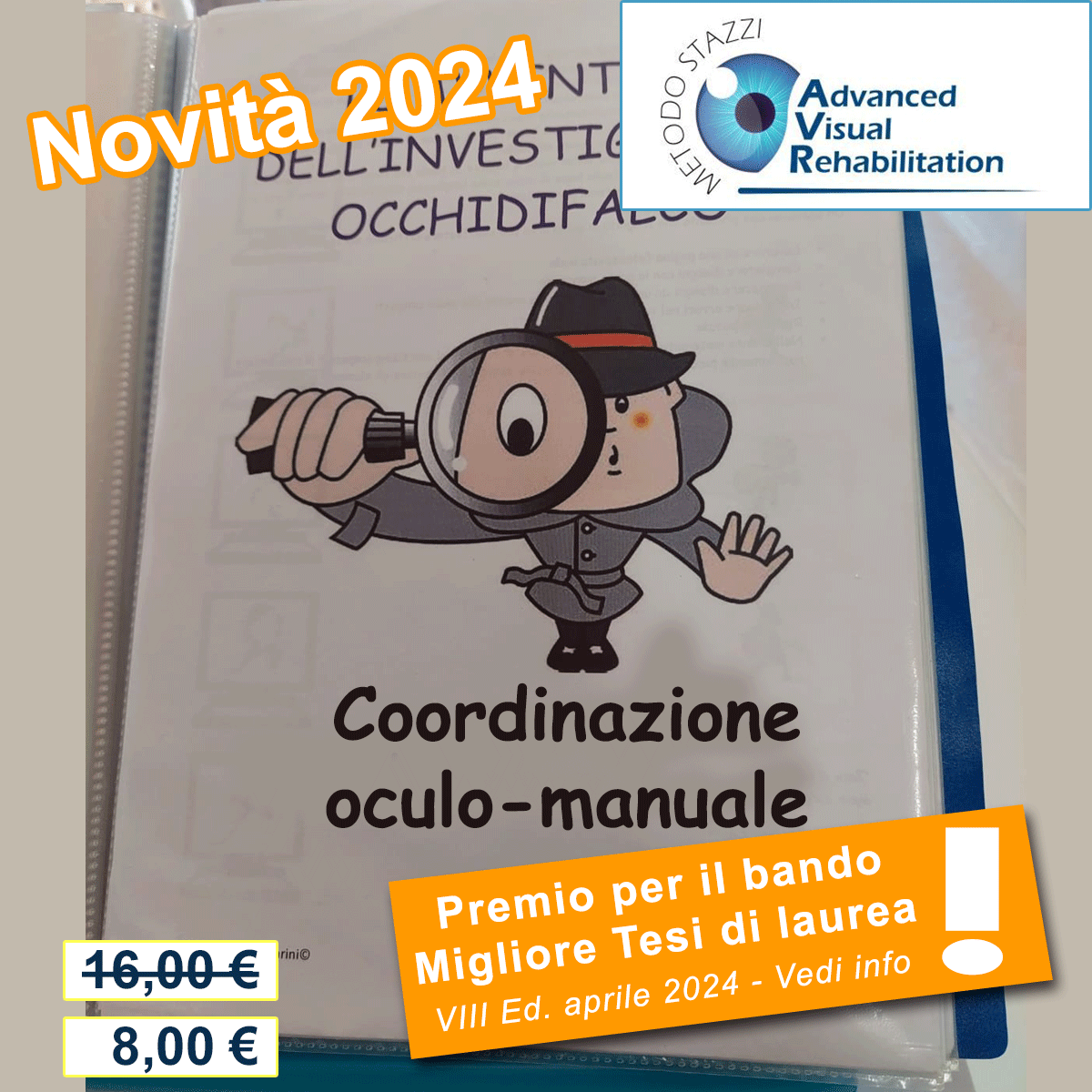BIBLIOGRAFIA E SITOGRAFIA - La pianificazione: esecuzione del movimento e funzione esecutiva nell'emiparesi spastica
- Ajuriaguerra J. de, Manuale di psichiatria del bambino, Masson, 1979, Milano.
- Alexander G.E., DeLong M.R., Strick P.L., Parallel organization of functionally segregated circuits linking basal ganglia and cortex, Annu Rev Neurosci, 1986; vol. 9, p. 357–381.
- Alghamdi M.S., Chiarello M.A., Palisano R.J., et al., Understanding participation of children with cerebral palsy in family and recreational activities, Research in Developmental Disabilities, 2017, vol. 69, p. 96-104.
- Ames K.C., Churchland M.M., Motor cortex signals for each arm are mixed across hemispheres and neurons yet partitioned within the population response, Elife, 2019, vol. 8.
- Anderson C.T., Sheets P.L., Kiritani T., et al., Sublayer-specific microcircuits of corticospinal and corticostriatal neurons in motor cortex, Nature, 2010, vol. 13 (6), p.739-744.
- Anderson P., Assessment and Development of Executive Function (EF) During Childhood, Child Neuropsychology, 2002, vol. 8 (2), p. 71-82.
- Aron A.R., Progress in Executive Function Research: From Tasks to Functions to Regions to Networks, Current Directions in Psychological Science, 2008, vol. 17 (2), p. 124-129.
- Atance, C., O'Neill, D. K., Planning in 3-year olds: A reflection of future self. In C. Moore & K.Lemon ,The self in time: Developmental perspectives (p. 121–140), Lawrence Erlbaum Associates, 2001, New York.
- Auld M.L., Boyd R., Moseley G.L., et al., Tactile function in children with unilateral cerebral palsy compared to typically developing children, Disability and Rehabilitation, 2012, vol. 34 (17), p.1488-1494.
- Barcelo F., Knight R.T., Both random and perseverative errors underline WCST
- deficits in prefrontal patients, Neuropsycologia, 2002, vol. 40 (3), p. 349-356.
- Barkley R.A., Behavioral Inhibition, Sustained Attention, and Executive Functions: Constructing a Unifying Theory of ADHD, Psychological Bulletin, 1997, vol. 121 (1), p. 65-94.
- Bax M. C. O., Terminology and Classification of Cerebral Palsy, Developmental Medicine & Child Neurology,1964, vol. 6, p. 295-307.
- Bax M., Terminology and classification of cerebral palsy, Developmental Medicine and Child Neurology, 1964, vol.6, p.295-307.
- Bax M., Goldstein M., Rosenbaum P., et al., Proposed definition and classification of cerebral palsy, Developmental Medicine and Child Neurology, 2005,vol. 47 (8), p. 571-576.
- Berthoz A., Il senso del movimento, McGraw-Hill, 1998, Milano.
- Berti E., Comunello F., Corpo e mente in psicomotricità. Pensare l'azione in educazione terapeutica, Erikson, 2011, Trento.
- Berti E., Comunello F., Savini P., Il contratto terapeutico in terapia psicomotoria, Edizioni junior, Spaggiari, 2015, Parma.
- Bridge Denckla M., Mahone E.M., Executive function: binding together the definitions of attention-deficit/hyperactivity disorder and learning disabilities, in Meltzer L., Executive function in education From theory to practice, The Guilford Press, 2018, New York.
- Briellmann R.S.., Abbott D.F., Caflisch U., et al., Brain reorganisation in cerebral palsy: a high-field functional MRI study,Neuropediatrics, 2002, vol.33(3), p. 162-165.
- Bumin G., Kavak S.T., An investigation of the factors affecting handwriting performance in children with hemiplegic cerebral palsy, 2008, Disability and Rehabilitation, vol.30 (18), p. 1374-1385.
- Camaioni L., Di Blasio P., Psicologia dello sviluppo, Il Mulino, 2007, Bologna. Cammisuli D., Timpano Sportiello M., Danti S., Planning deficit in patients with Mild Cognitive Impairment , Journal of Gerontology and Geriatrics, 2013, vol. 61, p. 273-278.
- Carlson S.M., Moses L.J., Claxton L.J., Individual differences in executive functioning and theory of mind: An investigation of inhibitory control and planning ability, Journal of Experimental Child Psychology, 2004, vol. 87, p.299-319.
- Chiarello L.A., Bartlett D.J., Palisano R.J., et al., Determinants of participation in family and recreational activities of young children with cerebral palsy, Disability and Rehabilitation, 2016, vol.38 (25), p. 2455-2468.
- Chinier E., N'Guyen S., Lignon G., et al., Effect of Motor Imagery in Children with
- Unilateral Cerebral PAlsy: fMRI Study, PLoS One, 2014, vol. 9 (4).
- Cioni G., Belmonti V., Paralisi Cerebrale Infantile: clinica,in Sandrini G., Dattola R. Compendio di Neuroriabilitazione: dai quadri clinici alla presa in carico della disabilità, Verduci Editore, 2012, Roma.
- Cioni G., Sales B., Paolicelli P. B., et al., MRI and Clinical Characteristics of children with hemiplegic cerebral palsy, 1999, Neuropediatrics, vol. 30, p. 249-255.
- Coleman A., Weir K.A., Ware R.S., et al., Relationship between communication skills and gross motor function in preschool-aged children with cerebral palsy,Archives of Physical Medicine and Rehabilitation, 2013,vol. 94 (11), p. 2210-2217.
- Comalli P. E. Jr., Wapner S., Werner H., Interference effects of Stroop Color-Word Test in childhood, adulthood, and aging, The Journal of Genetic Psychology, 1962, vol. 100, p.47-53.
- Cooper J., Majnemer A., Rosenblatt B., et al., The determintion of sensory deficits in children with hemiplegic cerebral palsy, Journal of Child Neurology, 1995, vol. 10 (4), p. 300-309.
- Crajè C., Kamp J. van der, Steenbergen B.,Visual information for action planning in left and right congenital hemiparesis,Brain Research, 2009, vol. 1261, p. 54-64.
- Elliott R., Executive function and their disorders, British Medical Bulletin, 2003, vol. 65, p. 49–59. Frye, D. Development of intention: The relation of executive function to theory of mind. In Zelazo P. D., Astington J. W., Olson D. R., Developing theories of intention: Social understanding and self control (p. 119–132), Lawrence Erlbaum Associates, 1999, New York.
- Fung E.B., Samson-Fang L., Stallings V.A., et al., Feeding dysfunction is associated with poor growth and health status in children with cerebral palsy, 2002, Journal of the American Dietetic Association, vol.102 (3), p. 361-373.
- Funahashi, Neuronal mechanisms of executive control by the prefrontal cortex, Neuroscience Researsh, 2001, vol. 39, p. 147–165.
- Giannoni P., Zerbino L., Fuori schema, Springer-Verlag, 2004, Milano.
- Goodman R., Graham P., Psychiatric problems in children with hemiplegia: cross sectional epidemiological survey,British Medical Journal, 1996, vol. 312, p. 1065-1069.
- Gulati S., Sondhi V., Cerebral Palsy: An Overview, 2018, The Indian Journal of Pediatrics, vol. 85 (15), p.1006-1016.
- Habermas J., Razionalità nell'azione e razionalizzazione sociale, Il Mulino, 1981, Bologna.
- Hauk O. , Johnsrude I. , Pulvermuller F., Somatotopic representation of action words in human motor and premotor cortex, Neuron ,2004, vol.41(2), p.301–307.
- Katz N., Cermak S., Shamir Y., Unilateral neglect in children with hemiplegic cerebral palsy,Perceptual and Motor Skills, 1998, vol.86 (2), p.539-550.
- Kiessling L.S., Denckla M.B., Clarton M., Evidence for diffferential hemispheric function in children with hemiplegic cerebral palsy, Developmental Medicine and Child Neurology, 1983, vol. 25 (6), p. 727-734.
- Li N., Chen T.W., Guo Z.V., et al., A motor cortex circuit for motor planning and movement,Nature, 2015, vol. 519 (7541), p. 51-56.
- Li N., Daie K., Svoboda K. et al., Robust neuronal dynamics in premotor cortex during motorplanning, Nature, 2016, vol. 532 (7600), p. 459-464.
- MacLennan A., Thompson S.C., Gecz J., Cerebral palsy: causes, pathways, and the role of genetic variants, American Journal of Obstetrics and Gynecology, 2015, vol. 213 (6), p. 779-788.
- Mencacci C., Durbano F., Anniverno R., Cognitive functions, rehabilitation and psychosocial reintegration: the role of second generation antipsychotics, Rivista di psichiatria, 2001, vol. 36, p. 28-37.
- McColgan, K. L., & McCormack, T., Searching and planning: young children's reasoning about past and future event sequences, Child Development, 2008, vol. 79(5), p. 1477- 1497.
- Milani Comparetti A., Gidoni E.A., Pattern analysis of motor development and its disorders, Developmental Medicine and Child Neurology ,1967, vol. 9 (5), p. 625-30.
- Militerni R., Neuropsichiatria infantile, Idelson-Gnocchi, 2015, Napoli.
- Moran S., Gardner H., Hill, Skill and Will: Executive Function from a Multiple Intelligence Perspective, in Meltzer L., Executive function in education From theory to practice, The Guilford Press, 2018, New York.
- Morin, C., Thibierge, S., Perrigot, M., Brain, body image and language: a psychoanalytic perspective, Journal of Mind and Behaviour., 2001, vol.22, p. 69–89.
- Nuara A., Papangelo P., Avanzini P., et al., Body Representation in Chhildren With Unilateral Cerebral Palsy, Frontiers in Psychology, 2019, 10:354.
- Odding E., Roebroeck M.E., Stam H.J., The epidemiology of cerebral palsy: Incidence, impairments and risk factors, Disability and Rehabilitation, 2005, vol. 28, p.183-191.
- Olney S.J., Wright M.J., Cerebral Palsy, in Campbell S.K. , Physical therapy for children, Saunders, 2005, St Louis.
- Paneth N, Hong T, Korzeniewski S., The descriptive epidemiology of cerebral palsy, Clinics in Perinatology. ,2006, vol.33, p. 251-267.
- Rizzolatti G., Fadiga L., Gallese V., et al., Premotor cortex and the recognition of motor actions, Cognitive Brain Research, 1996, vol. 3, p. 131-141.
- Rizzolatti G., Fogassi L., Gallese V., Motor and cognitive functions of the ventral premotor cortex,Current Opinion in Neurobiology, 2002, vol. 12, p. 149-154.
- Robertson, I. H., Hawkins K., Limb activation and unilateral neglect, Neurocase, 1999, vol. 5, p.153 – 160.
- Rosenbaum P., Paneth N., Leviton A., et al., A report: the definition and classification of cerebral palsy, Developmental Medicine and Child Neurology. Supplement, 2006, vol.109, p. 8-14.
- Sheets P.L., Shepherd G.M.G., Cortical Circuit for Motor Control, Neuropsychopharmacology, 2011, vol. 36 (1), p. 365-366.
- Steenbergen B., Gordon A.M., Activity limitation in hemiplegic cerebral palsy: evidence for disorders in motor planning, Developmental Medicine & Child Neurology, 2006, vol. 48, p. 780-783.
- Steenbergen B., Jongbloed-Perboom M., Spruijt S., et al., Impaired motor planning and motor imagery in children with unilateral spastic cerebral palsy:challenges for the future of pediatric rehabilitation, Developmental Medicine & Child Neurology, 2013, vol. 55 (4), p 43-46.
- Steenbergen B., Verrel J., Gordon A.M., Motor planning in congenital hemiplegia, Disability and rehabilitation, 2007, vol. 29 (1), p. 13-23.
- Stuss D.T., Functional of the Frontal Lobes: Relation to Executive Functions, Cambridge University Press, 2011, vol. 17, p. 759-765.
- Stuss D.T., Benson F.D., The Frontal Lobes, New York Raven Press, 1986, vol. 149 (3), p. 393-394.
- Svoboda K., Li N., Neural mechanisms of movement planning: motor cortex and beyond, Current Opinion in Neurobiology, 2018, vol. 49, p. 33-41.
- Valente D., Fondamenti di riabilitazione in età evolutiva, Carocci Faber, 2015, Roma.
- Van Zelst B.R., Miller M.D., Russo R., et al., Activities of daily living in children with hemiplegic cerebral palsy: a cross-sectional evaluation using the Assessment of Motor and Process Skills, Developmental Medicine and Child Neurology, 2006, vol. 48(9), p. 723-727.
- Vargha-Khandem F., Isaacs E., Van Der Werf S., et al., Development of intelligence and memory in children with hemiplegic cerebral palsy. The deleterious consequences of early seizures", Brain, 1992, vol. 115 (1), p. 315-29.
- Von Cranach M. e Harrè R., L'analisi dell'azione-recenti sviluppi teorici ed empirici, Giuffrè, 1982, Milano.
- Winters J.T., Gage J.R., Hicks R., Gait patterns in spastic hemiplegia in children and young adults, Journal of Bone and Joint Surgery, 1987, vol. 69 A, p. 438.
- Welsh M.C., Pennington B.F., Groisser D.B., A normative-developmental study of executive function: A window on prefrontal function in children, Developmental Neuropsychology, 1991, vol. 7 (2), p. 131-149.
- Zelazo P.D., The development of conscious control in childhood, Trends in Cognitive Sciences, 2004, vol. 8, p. 12-17.
- Zelazo P.D., Craik F.I.M., Booth L., Executive function across the life span, Acta Psychologica, 2004, vol. 115, p. 167-183.
- Zelazo P.D., Frye D., Cognitive complexity and control: The development of executive function, Current Directions in Psychological Science, 1998, vol. 7, p. 121- 126.
www.neuroscienze.net/la-personalita-e-nel-lobo-frontale-lo-strano-caso-di-phineas-gage/
































